Issue Date: Monday 14th November 2016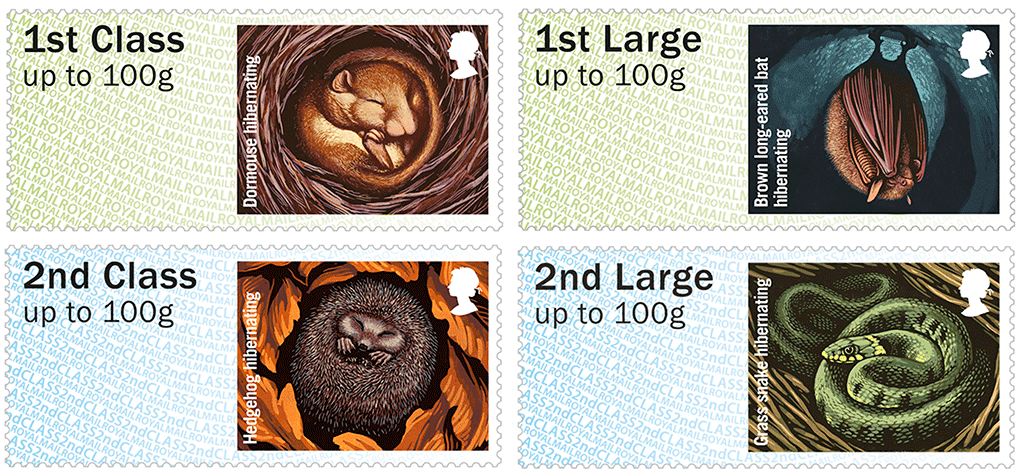
REASON & INSPIRATION
Hibernation is an extended period of deep sleep that allows animals to survive winter extremes. Reducing metabolic rate and lowering body temperature enables survival through cold periods when food is scarce or has little energy value. Hibernating species 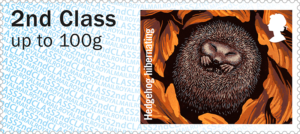 usually work hard to build up large fat reserves before they bed down, and subsist on this during their sleep. They might wake up at intervals to defecate or top up on food. Few British mammals hibernate during the winter – only the dormouse, hedgehog and the bat species.
usually work hard to build up large fat reserves before they bed down, and subsist on this during their sleep. They might wake up at intervals to defecate or top up on food. Few British mammals hibernate during the winter – only the dormouse, hedgehog and the bat species.
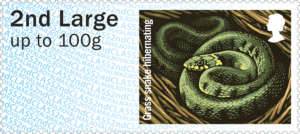 British snakes also hibernate through the winter months. The grass snake is the UK’s largest snake, growing to 150cm in length and identifiable by its yellow or cream band behind the head and its delicate body markings. They live in a wide range of wetland habitats but also venture into gardens. Grass Snakes eat as much as possible before they go into hibernation to store up enough fat in their bodies to live off during their long winter sleep.
British snakes also hibernate through the winter months. The grass snake is the UK’s largest snake, growing to 150cm in length and identifiable by its yellow or cream band behind the head and its delicate body markings. They live in a wide range of wetland habitats but also venture into gardens. Grass Snakes eat as much as possible before they go into hibernation to store up enough fat in their bodies to live off during their long winter sleep.
Technical Details:
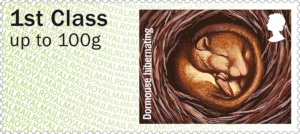 Number of stamps:Four
Number of stamps:Four
Date of issue: 14th November 2016
Design: Osborne Ross
Illustrations: Chris Wormell
Acknowledgements: illustrations and sketches by Chris Wormell Card design © Royal Mail Group Ltd 2016
Printer: International Security Printers
Process: Gravure
Format: Landscape
Size: 56mm x 25mm
Perforations: Die-cut simulated
Phosphor: Bars as appropriate
Gum: Self-adhesive
 As overprinted by Post & Go machine: Hedgehog As hedgehogs get ready to hibernate, their body temperature drops down to as low as 2°C, and after that they enter a period of deep sleep. They often use piles of dead leaves and vegetation in gardens as shelter, which means that they are particularly vulnerable when garden bonfires are lit.
As overprinted by Post & Go machine: Hedgehog As hedgehogs get ready to hibernate, their body temperature drops down to as low as 2°C, and after that they enter a period of deep sleep. They often use piles of dead leaves and vegetation in gardens as shelter, which means that they are particularly vulnerable when garden bonfires are lit.
 As overprinted by Post & Go machine: Grass snake Like all reptiles, grass snakes are cold-blooded and rely on basking in the sun to remain active. As the days get shorter, there is insufficient sun, so they crawl under piles of vegetation or into cracks in banks. They emerge in early summer and can be found basking in the sun once again.
As overprinted by Post & Go machine: Grass snake Like all reptiles, grass snakes are cold-blooded and rely on basking in the sun to remain active. As the days get shorter, there is insufficient sun, so they crawl under piles of vegetation or into cracks in banks. They emerge in early summer and can be found basking in the sun once again.
As overprinted by Post & Go machine:Dormouse Dormice can  spend over half the year in hibernation. Indeed, their name might come from this trait, from the Latin word for sleep, dormire. They bed down in carefully constructed nests, woven from strands of honeysuckle bark and dried grass, for instance, well hidden in their woodland habitat.
spend over half the year in hibernation. Indeed, their name might come from this trait, from the Latin word for sleep, dormire. They bed down in carefully constructed nests, woven from strands of honeysuckle bark and dried grass, for instance, well hidden in their woodland habitat.
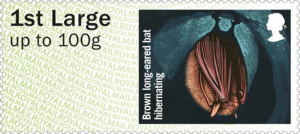 As overprinted by Post & Go machine: Brown long-eared bat Bats rely on a constant source of insects to eat. As the supply of these dwindles in the autumn, they find special hibernation roosts, often returning to the same location year after year. Bats prefer to hibernate at very cold temperatures and are often found in caves and old mine shafts.
As overprinted by Post & Go machine: Brown long-eared bat Bats rely on a constant source of insects to eat. As the supply of these dwindles in the autumn, they find special hibernation roosts, often returning to the same location year after year. Bats prefer to hibernate at very cold temperatures and are often found in caves and old mine shafts.



